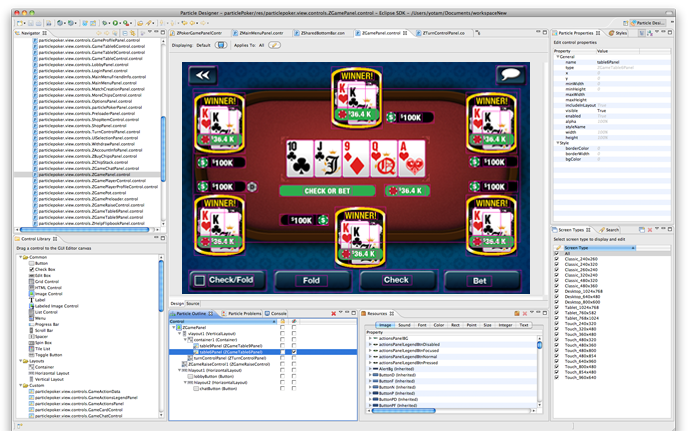When it comes to app development for mobile devices, cross-platform implementation is the new hot thing. Developers have long struggled with fragmentation across operating systems, when they want to just be able to create one app and blast it out on every platform imaginable. Businesses like Heroku and Appcelerator, and gaming versions like Game Closure (and many others) collectively make creating, hosting, and deploying games a more manageable endeavor. But today, a startup is launching that hopes to make development of mobile apps even easier.
Palo Alto-based Particle Code is building a platform that enables mobile developers to write mobile apps and games once, deploy both HTML5 and native apps across platforms and devices — all from within a single codebase. Particle Code is built on the Eclipse IDE, an environment and suite of tools for Java developers, and supports development in a wide array of languages including Java, C# and ActionScript3. This means millions of additional programmers can now enter mobile app development in a way that is scalable to reach a whole bunch of devices. And, as a potentially interesting aside, here’s TIOBE’s ranking of the most popular programming languages this month.
Today’s data-driven app environment requires developers to iterate on content quickly, and pushing updates across a number of platforms is, just as it sounds, not so easy. So Particle Code helps developers iterate quickly and push changes cross-platform seeing as the app is written in one codebase. And yet it still produces native apps on every device. The secret is translating code on the source code level, rather than wrapping JavaScript in native extensions. So what started off as a Java or AS3 project, can end up as a native C# app on Windows Phone, for example.
Particle Code CEO Galia Benartzi tells me that Particle’s platform originated as part of Mytopia, a cross-platform publisher for networked casual games, that was acquired by 888 Holdings in June 2010. The Particle Code founding team (which includes CTO Yotam Shacham and Chief Architect Yudi Levi) retained rights to the cross-platform tech behind Mytopia after its acquisition, and used it to deliver the Particle SDK.
Benartzi said that Mytopia debuted at TC50 in 2008, at which point Ev Williams and Tim O’Reilly, who were both on the judging panel, told the founders they should focus either on games or a more general app development platform. At the time, the team decided to focus on games, but since Mytopia’s acquisition in 2010, they’re going one step further.
In the last year, HTML5 has taken some significant strides forward thanks to assistance from Microsoft, Google, Facebook, Apple, and more, and is gaining momentum as an alternative to native apps. But it’s still not there yet. While it contains the promise of unification, it’s still a work in progress that still hasn’t gained full browser support.
So, the Particle Code team has created a flexible environment that gives developers the chance to do both, create native and web applications, and harness the best of both worlds.
The key to Particle’s platform, she said, is that it allows coders to translate their code on the source code level, bringing app performance closer to what it would be with native code. If you were to include wrappers, you might see memory drain on your device, slower animations, poorer latency, etc., so Particle removes this obstacle by allowing developers to create native apps alongside web apps. The choice, grasshopper, is yours.
The startup originally funded its operations through cash received from its Mytopia exit, but it also raised $3 million in June of last year from Benhamou Global Ventures. It is looking to raise more cash in the near future, and expand upon its current team of 14.
